Caron Penney: The traditional skill of tapestry weaving
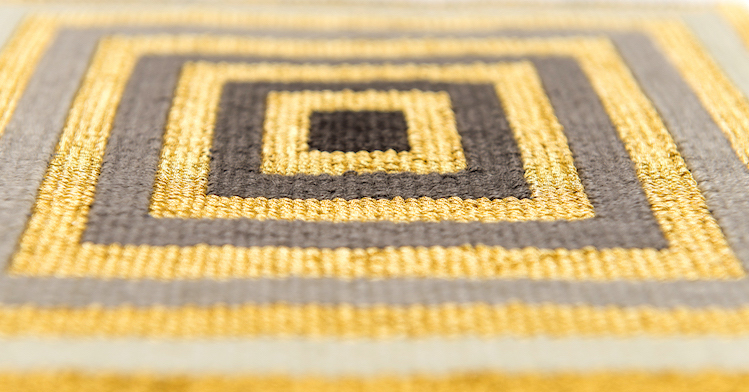
Caron Penney is a master tapestry weaver, she studied at Middlesex University and has worked in textile production for over twenty years. She is both an artisanal weaver and an artist and has manufactured the work of artists from Tracey Emin to Martin Creed.
Penney also creates and exhibits her own artist-led tapestries for exhibition and is known for her monochromatic palette of woollen threads interspersed with flashes of gold & red. She is based in West Sussex at the Mill Studio in Ford.
Her work has been exhibited across the UK and she is currently part of the Here and Now exhibition organised by National Centre for Craft and Design, Lincolnshire, touring to the Holburne Museum, Bath in 2017.
She is a member of the Contemporary Applied Arts and teaches tapestry at her own study, the Fashion & Textiles Museum, Morley College, Central Saint Martins and many other locations across the UK.
In this interview, Caron talks about her journey into the world of tapestry weaving and reveals who initially inspired her and what influences her work now. We learn how she develops her ideas and which direction she would like to see her work go in the future.
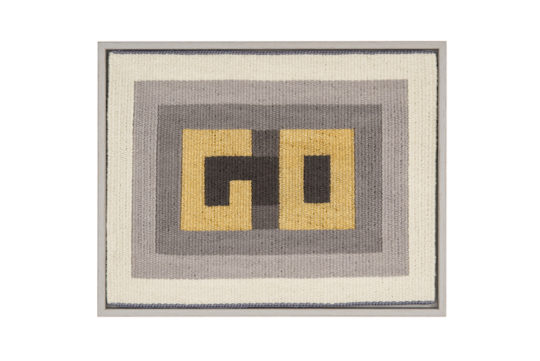
Caron Penney, Go_2008_2013, 26cm x 20cm, 2016, wool & gilt gold thread
Interpreting into tapestry
TextileArtist.org: What initially attracted you to textiles as a medium?
Caron Penney: Oddly I don’t see myself as a textile person. I studied art at school and sixth form college in Southampton which is my hometown.
My mother tried tirelessly to get me to sew and knit but I was dreadful at them and didn’t feel inspired. She was a good teacher, however, textiles represented function and domesticity for me at that time.
Art is my first love, and it wasn’t until I got to Foundation at Portsmouth College of Art that I started moving toward textiles as an art form.
And, more specifically, how was your imagination captured by tapestry?
My interest in tapestry weaving started when I visited Middlesex University in 1989 and consequently decided that I would apply for the BA Constructed Textiles degree.
Over the three years I was there I realised that I loved interpreting my drawings into tapestry and further loved investigating colour in the dye rooms at Middlesex. I found that the depth of colour I could achieve on wool and cotton far exceeded that which I could achieve when creating an image in paint.
Back then my work was driven by landscape primarily making reference to mother nature and there was a lot of crimson red, blood red, deep purple, and dark blue.
When I left University I thought that I knew quite a lot about my specialism but I swiftly recognised that there was so much more to learn.
I didn’t fully understand how hooked I was until I started working at West Dean Tapestry Studio (WDTS) in 1993. The Studio Director, Valerie Power dedicated most of her working life to tapestry and was an inspiration for many reasons. Valerie was a skilled master weaver who was running the department and she became a role model. It was here that I decided that I wanted to follow in her footsteps.
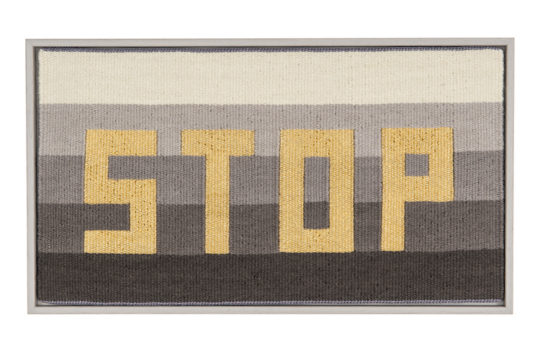
Caron Penney, Stop_2008_2013, 38cm x 20cm, 2016, wool & gilt gold thread
What or who were your influences?
Valerie helped me develop a deep enquiry into the traditional skill of tapestry weaving. This enquiry coupled with working with artists and being part of that world inspired me to further my own enquiry as an artist.
I can honestly say that I have been influenced by every artist I have worked with as a master weaver, each person touches you and your work to some degree. You give something back as well, the artist and the maker are intrinsically linked.
Influences in my career are as far reaching as Archie Brennan because he was the Director of the Dovecot Studios in Edinburgh and looked at tapestry in a new way, to the artists Louise Bourgeois, Joseph Albers, and Agnes Martin. Bourgeois helped free up my thinking and create more confidence in what I was making, whereas I love the structure and principle to Albers drawings and painting. Also working with Martin Creed and understanding the honesty of his approach changed my own artistic identity.
What was your route to becoming an artist?
I worked for WDTS for over 20 years and was the Director for 4 years and a Consultant for 18 months toward the end of my tenure there. During this time I realised that I enjoyed translating artists work into tapestry and certainly at the beginning of my time there I stopped making my own designed tapestries.
Since 2008 I have begun drawing again and started using tapestry to develop these ideas. Since leaving WDTS full time in 2013 I have been able to concentrate on my own practice and develop myself as an artist.
In 2016 I was selected for the Contemporary Applied Arts and the 62 Group, which was a great achievement. I feel that I am on a route to becoming the artist I want to be and in 2014 I was selected for inclusion in the Summer Exhibition at the Royal Academy of Arts, this was a great moment both for me and it was a great experience.
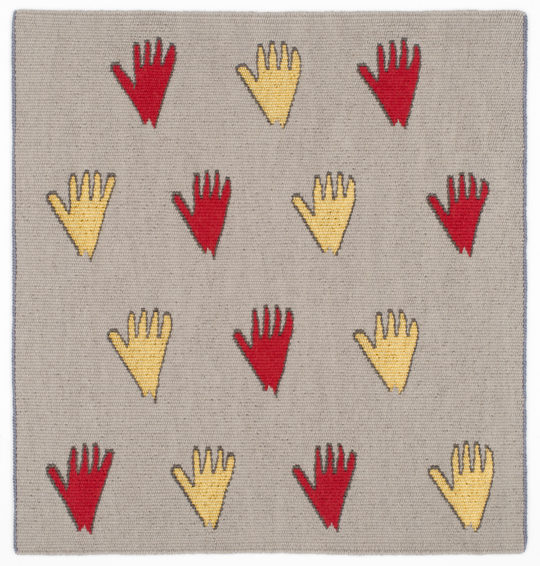
Caron Penney, Golden handshake, 2016, 41cm x 43cm, wool & gilt gold thread
The meticulous repetition of patterns and shapes
How would you describe your work and where do you think it fits within the sphere of contemporary art?
My artistic practice has evolved around a central theme of Manhattan since I first visited the city in 2001. I react to the urban landscape and the systems and patterns that repeat across the streets and avenues. Often these themes respond to the ebb and flow of the daily migration across the City.
The subject matter draws comparisons between societies need to function and the individuals need for identity and their subtle co-existence. This careful balance is represented in the meticulous repetition of patterns and shapes in my tapestries and I reproduce familiar visual signs arranging them in sequences and rhythms.
My ideas develop through observation, photography, sketches and the resulting tapestries. I use the same limited range of materials traditionally used to make hand-woven tapestry, with the addition of dyed cotton warp thread which edges the finely woven pieces.
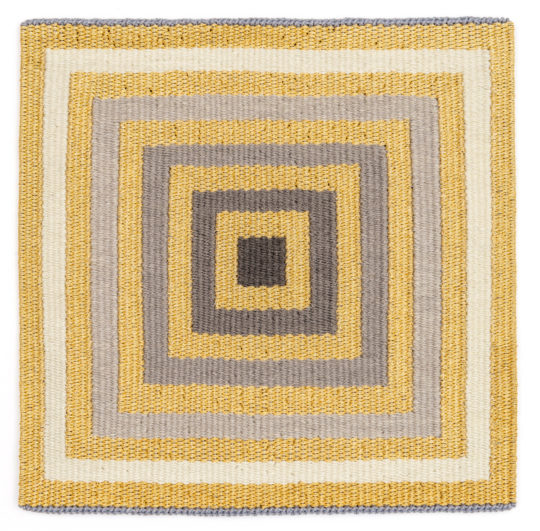
Caron Penney, The streets are paved with gold, 2016, 19cm x 20cm, wool & gilt gold thread
My latest work concentrates on the extract, the streets are paved with gold, from the 19th-century story of Dick Whittington. The ironic nature of these words became reality for me, when on the 15 September 2008 I was walking down 7th Avenue, New York City. I unwittingly observed the employees of Lehman Brothers Holdings Inc. leaving their headquarters after the company had filed for bankruptcy. These events were to be seen by many as the beginning of the global financial crisis.
I am now working on a series of tapestries using golden threads. The use of gold is a witty comment on events that unraveled both globally and personally over the years that followed.
In this series of works, I embrace duality such as lightness and heaviness, illusion and reality, obscenity and refined aesthetic. My work hovers between the abstract and the figurative, creating a window into a world which is both mysterious and familiar.
Do you use a sketchbook? If not, what preparatory work do you do?
My sketchbooks hold all the clues to my tapestries. I use a Molestine squared paper A4 portfolio books and I love drawing in pencil and also use coloured crayons and gold gouache paint. The squared paper corresponds to the warp and weft in my tapestries, and everything is very carefully calculated and planned in advance.
I enjoy systems and patterns but didn’t realise this until later in my development as an artist. At the moment it is a key feature which I am expressing to its full in my sketchbooks and then selected works make it to the loom.
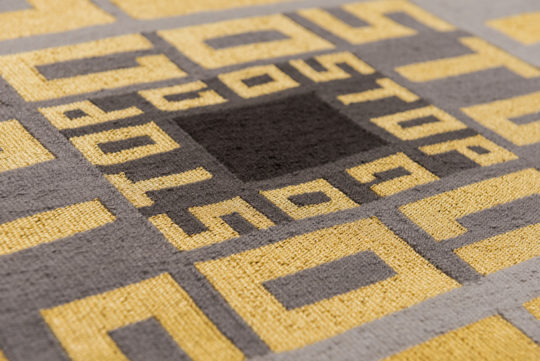
Caron Penney, Stop_Go_2008_2013, 62cm x 92cm, 2016, wool & gilt gold thread
Keeping focus
What environment do you like to work in?
I have a lovely studio in West Sussex, which I share with my partner Katharine Swailes. It is a brilliant space – full of light and very relaxing. I make all my tapestries there.
The sketches and ideas are developed anywhere that suits from the train, to home, to a beautiful cottage in Cornwall. The ideas can develop anywhere and at any time, however, I really like silence.
How has your work developed since you began and how do you see it evolving in the future?
My work seems to have evolved from being very figurative to more abstract which I really like. It’s always had a personal agenda and I used to say it was autobiographical but it has more of a political agenda these days. This feels right at the moment and how I would like to see my work moving.
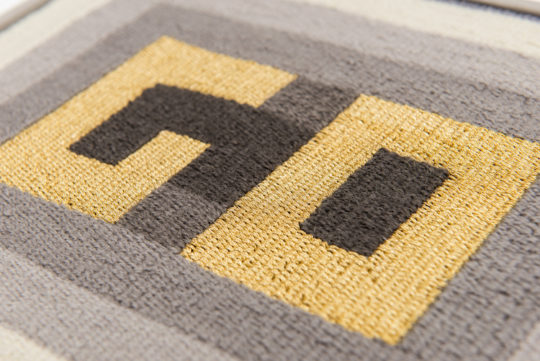
Caron Penney, Go_2008_2013, 26cm x 20cm, 2016, wool & gilt gold thread
What advice would you give to an aspiring textile artist?
Craft is evolving, it includes so many technologies from the hand made to the digital. The playing field is vast so it’s important to focus on the thing that excites you and also if you enjoy your work then someone else will.
Also keep at it even when it feels like everything is going wrong, all artists have this experience, have the faith that things will get better. You have to work it though, keep applying for things, talk to galleries and go to their private views, show an interest in them and they may show an interest in you. You have to work hard to be an artist but have fun too.
Can you recommend 3 or 4 books for textile artists?
Louise Bourgeois: The Spider and the Tapestries, Hauser & Wirth Collection
Josef Albers: The Interaction of Colour
Tapestry: A woven narrative, Black Dog Publishers
What other resources do you use? Blogs, websites, magazines etc.
Crafts magazine
Hole and Corner Magazine
RA Magazine
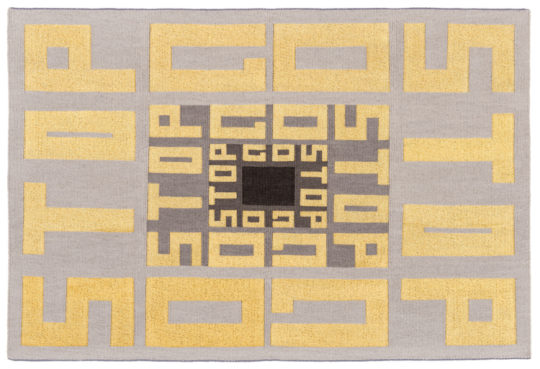
Caron Penney, Stop_Go_2008_2013, 62cm x 92cm, 2016, wool & gilt gold thread
What piece of equipment or tool could you not live without?
I love tools, from my bobbins to the materials I use, to the pencil, a very lovely pencil in a brass holder, to the sketchbooks and so on. They are all so crucial to me and my practice. I have to have all these tools in alignment to be able to work well.
As a weaver I have to have a loom and right now I have a stand alone black pipe loom which we acquired from a weaving friend. I love it and have now made loads of tapestries on it.
However, one tool I would be bereft about losing is the low warp bobbin given to me by Valerie Power before she left the studio. It is very special to me.
Do you give talks or run workshops or classes? If so where can readers find information about these?
I teach all the time, and really enjoy it. I mainly run short courses lasting from one day to six or seven days. I regularly teach from my own studio in Ford, West Sussex and at places like the Fashion & Textiles Museum, Morley College, Central Saint Martins, and West Dean College.
I also teach the occasional workshop at Museums, galleries and often these include coinciding the teaching with an event. This year I will be at Ditchling Museum Art + Craft, the Holburne Museum, Pallant House Gallery, and a few others. I advertise my workshops on my website.
Where can readers see your work this year?
I am exhibiting with the Here and Now exhibition curated by Lesley Millar. It should tour to Birmingham MAC and the Holburne Museum, Bath. I often have work at my gallery the Zimmer Stewart Gallery in Arundel and at the Contemporary Applied Arts in London. We are opening up our studio for the Chichester Art Trail in May this year.
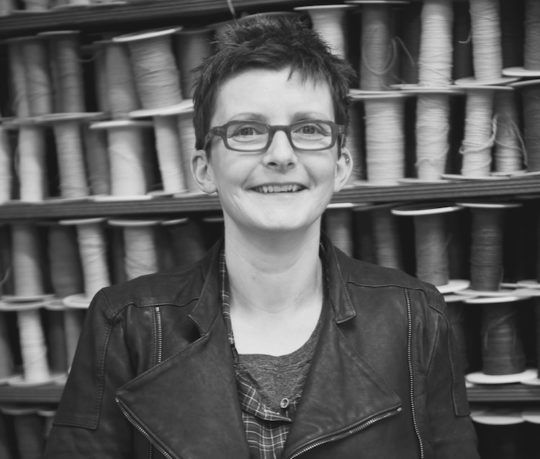
Caron Penney
For more information visit: www.weftfaced.com and further links below:
www.eventbrite.co.uk
www.craftscouncil.org.uk
www.62group.org.uk
Got something to say about the techniques, materials and processes used by this artist – let us know by leaving a comment below.
















Wonderful to see the inspiration and work of a master weaver with a contemporary twist